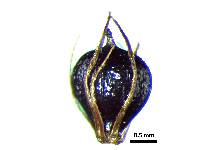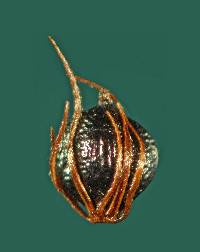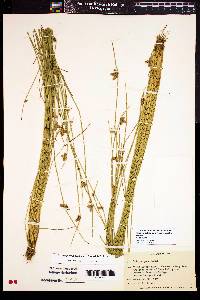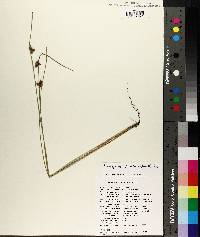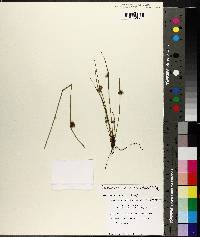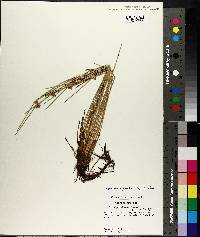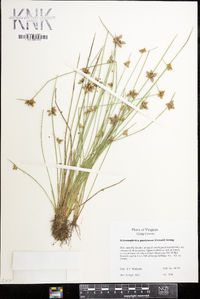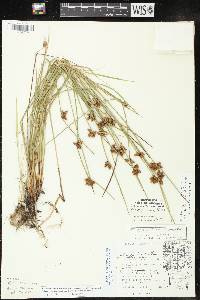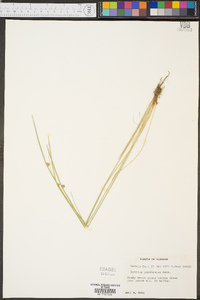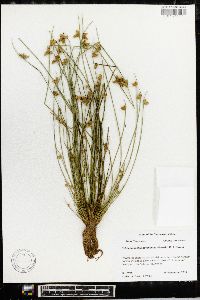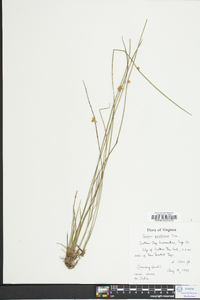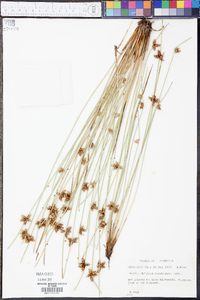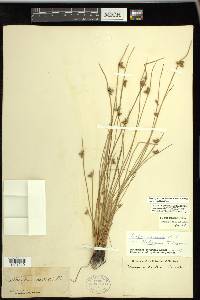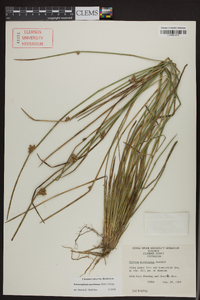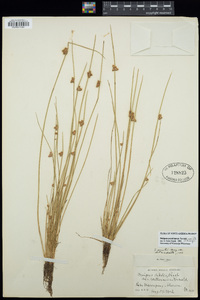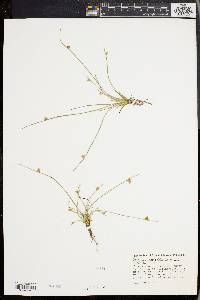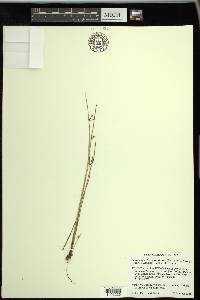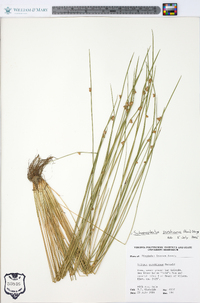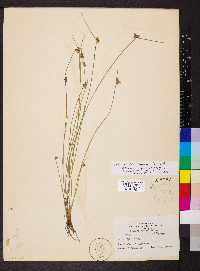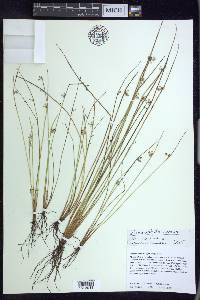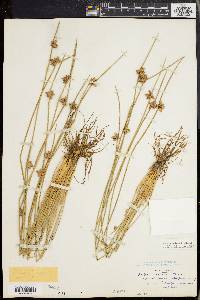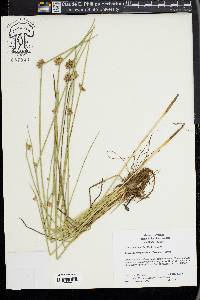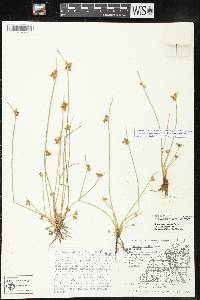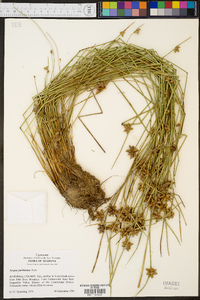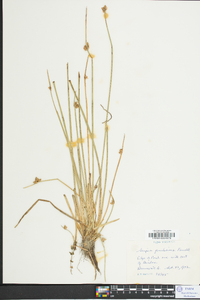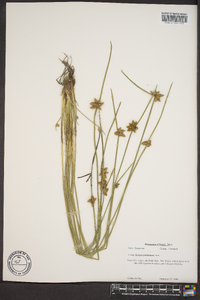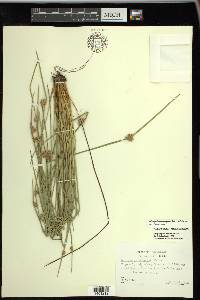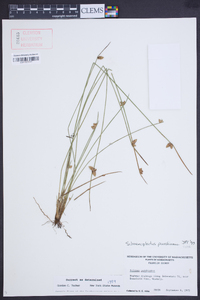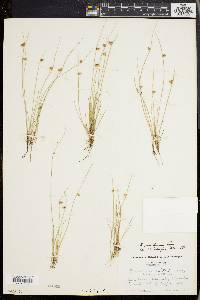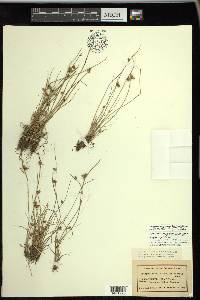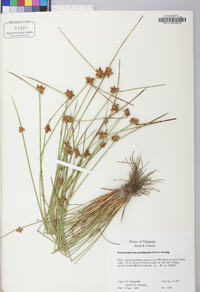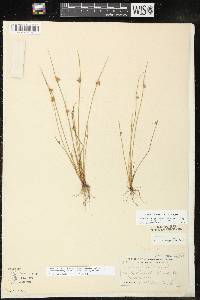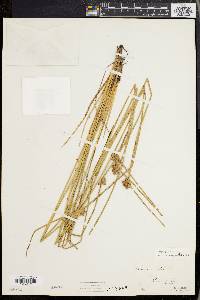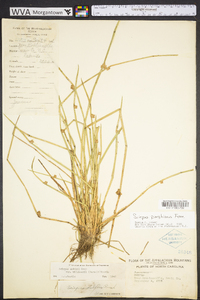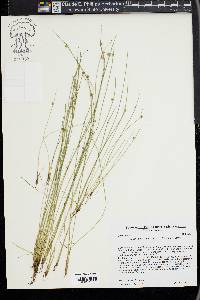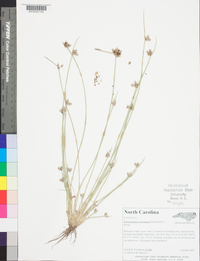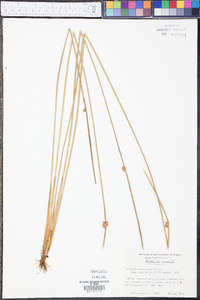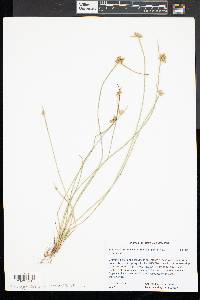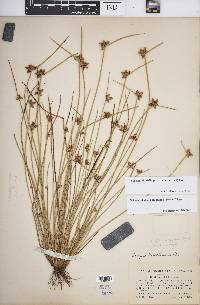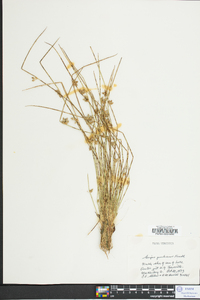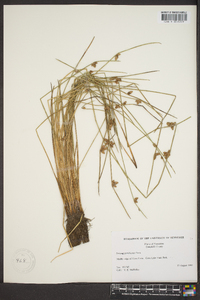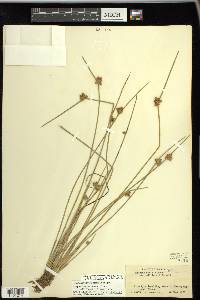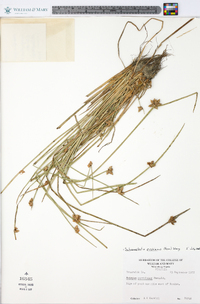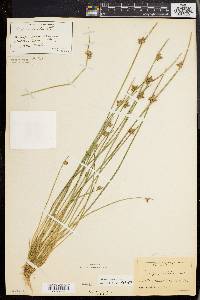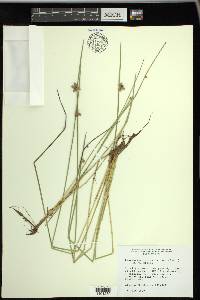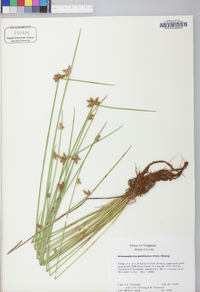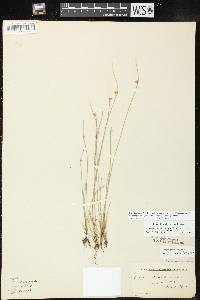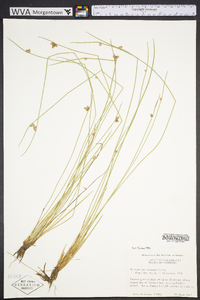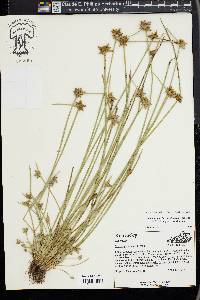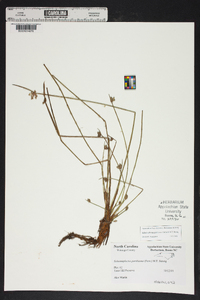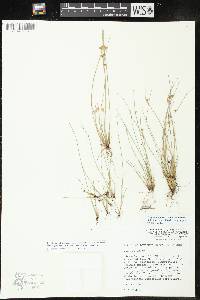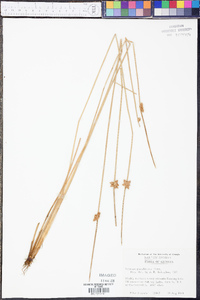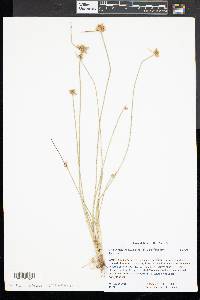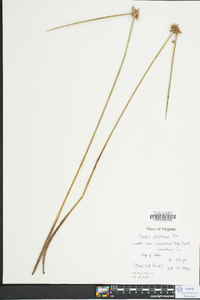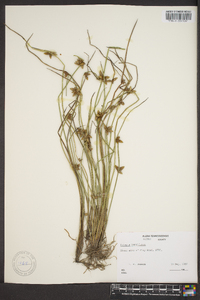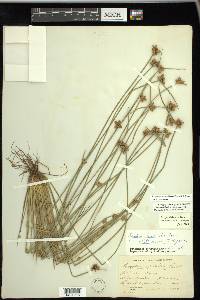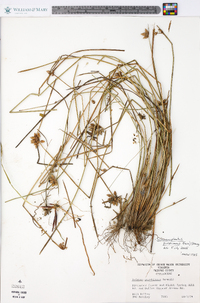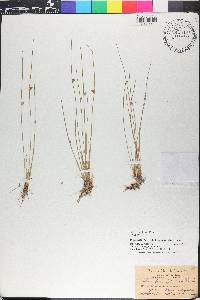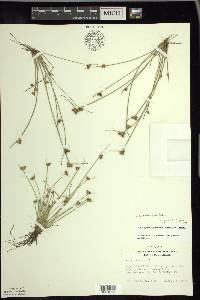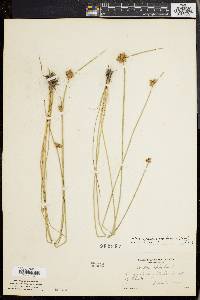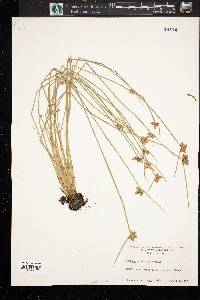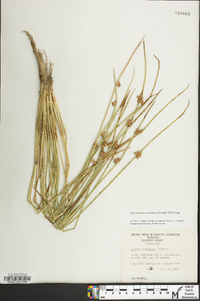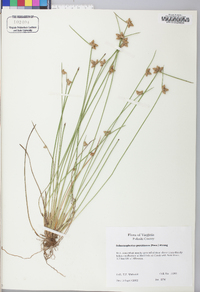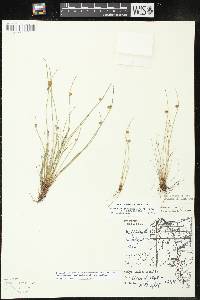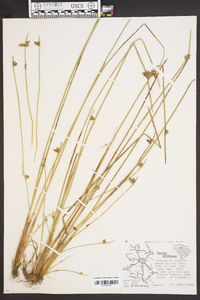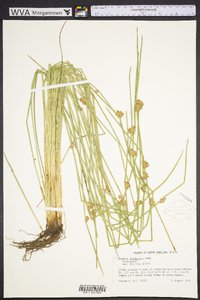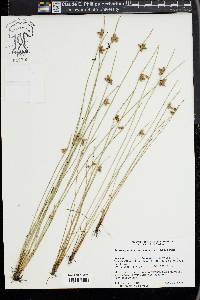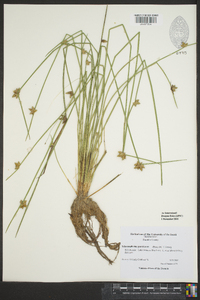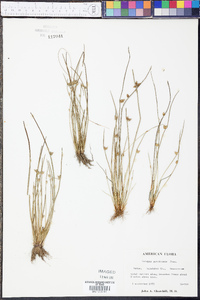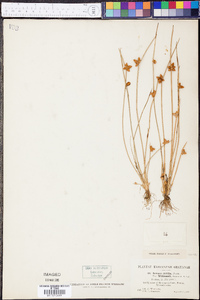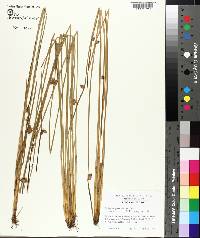Schoenoplectiella purshiana
|
|
|
|
Family: Cyperaceae
Weak-Stalk Bulrush, more...weak-stalk club-rush
[Schoenoplectiella purshiana var. purshiana, moreSchoenoplectus juncoides subsp. purshianus (Fernald) Soják, Schoenoplectus purshianus (Fernald) M.T. Strong, Schoenoplectus purshianus var. purshianus , Schoenoplectus purshianus var. williamsii (Fernald) S.G.Sm., Scirpus debilis var. williamsii , Scirpus hotarui auct. non Ohwi, Scirpus purshianus Fernald] |
Plants annual; rhizomes 1 mm diam. Culms often arching (to decumbent), cylindric, 0.1-1 m × 0.5-2 mm. Leaves 1, to equaling culm; sheath fronts not pinnate-fibrillose; blade 0 or 1, C-shaped in cross section, from a mucro to longer than a sheath, 0.5-1 mm wide, smooth. Inflorescences capitate or 1 spikelet; proximal bract erect or often divergent, subterete-channeled, on longer culms of plant 1-15 cm and 1/30-1/3 of culm length. Spikelets 1-12, 5-12 × 3-4 mm; scales straw-colored to orange-brown, often lineolate-spotted, midrib region often greenish, broadly obovate, 2.5-3 × 2.5 mm, smooth, margins ciliolate distally, flanks in proximal part of spikelet each with 2-10 distinct ribs, apex rounded, entire, mucronate. Flowers: perianth members 6, rarely absent, brown, bristlelike, equaling to slightly exceeding achene, distinctly wider proximally, densely retrorsely spinulose to appressed-spinulose; anthers 0.5-0.7 mm; styles 2-fid or 2-fid and 3-fid. Achenes brown, turning blackish, thickly biconvex, sometimes plano-convex or obscurely compressed-trigonous with rounded abaxial angle, abaxial face with central bulge, obovoid, proximally rounded to distinct stipelike constriction, 1.6-2.2 × 1.2-1.5 mm, base 0.3-0.4 mm wide; beak 0.1-0.3 mm. Culms of Schoenoplectus purshianus have been described erroneously as trigonous (e.g., M. L. Fernald 1950). Schoenoplectus purshianus is widely confused with S. smithii; they are clearly distinct (M. Blondeau et al. 1996; S. G. Smith and E. Hayasaka 2002). Some authors (A. A. Beetle 1942b; H. A. Gleason 1952; H. A. Gleason and A. Cronquist 1963; E. G. Voss 1972-1996) have placed S. purshianus (as Scirpus) in synonymy under Schoenoplectus smithii, and most published distributions are erroneous. The taxonomic confusion is because of the subtle nature of the diagnostic characteristics of achenes and perianth bristles, the occurrence in both species of plants with or without bristles, and overlapping involucral bract lengths and frequency of divergence. No intermediates are known; although the two species occasionally grow together they are not known to hybridize. Close examination of the perianth bristles and achenes of S. purshianus and S. smithii reveals taxonomically useful but overlooked differences as stated in the key and summarized under S. smithii. Schoenoplectus purshianus has also been confused with its close relatives in sect. Actaegeton: Schoenoplectus juncoides (Roxburgh) Palla, S. hotarui (Ohwi) Holub, and Scirpus rockii Kükenthal, which belong to the difficult 'Scirpus juncoides complex' of eastern Asia, the Pacific islands, and eastern North America; Schoenoplectus purshianus should be treated as a distinct North American species pending further research (S. G. Smith and E. Hayasaka 2002). The name Scirpus erectus Poiret has been widely misapplied to members of that complex (see 17. Schoenoplectus erectus). The names Scirpus smithii var. williamsii (Fernald) Beetle, S. juncoides Roxburgh var. williamsii (Fernald) T. Koyama, and Schoenoplectus smithii subsp. williamsii (Fernald) Soják were misapplied by their authors to both S. purshianus var. purshianus and S. purshianus var. williamsii. Schoenoplectus purshianus var. purshianus: Perianth bristles present. 2n = 38. Fruiting summer-fall. Fresh-water shores, ponds, and ditches, usually drying, usually in sandy soils, often emergent, with relatively little water-level fluctuations; 0-1000 m; Ont., Que.; Ala., Conn., Del., D.C., Ga., Ill., Ind., Ky., Maine, Md., Mass., Mich., Minn., Mo., N.J., N.Y., N.C., Pa., R.I., Tenn., Va., W.Va., Wis. Schoenoplectus purshianus var. williamsii: Perianth bristles absent. 2n = 38. Fruiting summer to fall. Shores with relatively large water-level fluctuations; 20-300 m; Ind., Mass., Mich., Wis. Schoenoplectus purshianus var. williamsii is known only from the type locality in Massachusetts, several counties in Michigan, one county in Indiana, and two counties in Wisconsin. In southwestern Michigan it is reportedly frequent on sandy shores of lakes with considerable water-level fluctuation spring to fall; the typical variety is infrequent in those habitats and often grows on shores with relatively uniform water levels (A. E. Schuyler 1972). Schoenoplectus purshianus var. williamsii in recent years has been treated as Scirpus purshianus forma williamsii (Fernald) Fernald. It seems better to treat the taxon as a variety rather than a form, pending further research, because it reportedly occurs in habitats with more water-level fluctuation than S. purshianus var. purshianus (A. E. Schuyler 1972; S. G. Smith and E. Hayasaka 2002) and thus may be useful as an ecologic indicator, and because form status suggests that the taxon is trivial. Annual herb with 1 mm wide rhizomes, tufted 10 cm - 1 m tall Leaves: one, to as long as culm. Sheath fronts not bearing pinnate fibers. Ligules membranous. Blade zero or one, tiny or longer than sheath, 0.5 - 1 mm wide, C-shaped in cross-section, parallel-veined. Inflorescence: composed of one to twelve spikelets, terminal, subtended by bracts. Lowest bract leaf-like, upright or diverging, 1 - 15 cm long, nearly circular in cross-section and channeled. Flowers: minute, subtended by a floral scale, lacking sepals and petals, bearing six bristles (rarely none). Bristles brown, equal to or slightly longer than achene body, distinctly wider basally, strap-like, bearing small spines. Stamens three, exserted. Anthers about 0.5 mm long. Pistil one. Style linear, two-cleft or both two- and three-cleft. Fruit: a one-seeded achene, brown, becoming darker, 1.5 - 2 mm long (including beak), 1 - 1.5 mm wide, reverse egg-shaped with a rounded to stalk-like base, beaked, mostly widely biconvex. Culm: decumbent to arching, 10 cm - 1 m long, 0.5 - 2 mm wide, circular in cross-section, solid, internally spongy with air cavities. Spikelets: solitary or in clusters, 5 - 12 mm long, 3 - 4 mm wide, circular in cross-section, with eight or more floral scales. Floral scales spirally arranged, orangish brown to straw-colored with a greenish midrib and tiny lines or spots, 2.5 - 3 mm long, 2.5 mm wide, widely reverse egg-shaped with a rounded apex bearing a tiny point, minutely hairy-fringed towards the apex. The lower scales of the spikelet often bear two to ten distinct ribs along their flanks. Similar species: No information at this time. Flowering: late June to late September Habitat and ecology: Relatively frequent in the dune area of the eastern sector of the Chicago Region. Found growing along shorelines and in low sandy meadows. Rarer in the sandy districts inland. Occurence in the Chicago region: native Etymology: Schoenoplectus comes from the Greek words schoinos, meaning rush or reed, and plectos, meaning twisted, plaited, or woven, referring to the use of the culms for making useful objects. Purshianus is named after Frederick Traugott Pursh (1774-1820), the Saxon explorer and horticulturist who discovered this species. Author: The Morton Arboretum From Flora of Indiana (1940) by Charles C. Deam This species has been found in a few counties only in wet or mucky soil about sloughs in the dunes. |


